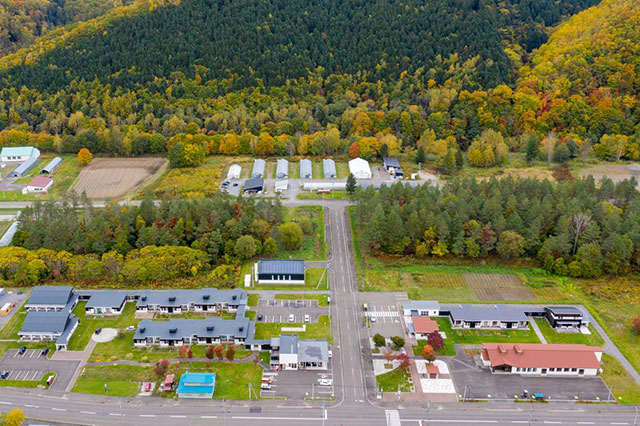
Surrounded 90% by forests, Shimokawa Town and its 3,400 resident sits directly in nature, and as far from big cities as you can find in basically all of Japan. Rather than define themselves purely by local industry, which is based on forestry, members of the town have been working for the last decade to build upon their “green” assets through new products, technology, and ways of living. While “being green” is now cliche in much of the world, Shimokawa has taken some pretty broad steps to embrace the movement in everyday life and on a practical, real level that can preserve their town for the future and lead as an example for sustainable solutions for other places as well.
-
![]()
![]()
In fact “Shimokawa Green” isn’t just a branding slogan or campaign, but an actual color that they developed by taking images of their particular local shades of green, working with color designers, and deciding as a town which hue matched them perfectly. You’ll now find Shimokawa Green used as a distinct, consistent color throughout their promotional materials, product packaging, and websites.
![]()
On the outskirts of the already small town of Shimokawa you’ll find Ichinohashi, one of the world’s more interesting experiments in ecologically-sound energy and lifestyle, and a direct response to the contemporary problems that the locals face with an aging population (like most of Japan).
![]()
With a population of only around 100 people, regional population decline, and with neighbors already far away from one another, it was looking a bit grim for the future of Ichinohashi. Starting only six years ago, in an attempt to save the village and do something a bit radical, they established the Bio Village.
![]()
![]()
Ichinohashi has always been a forestry town, with a sea of pine trees in the surrounding forests to support the industry providing wood for houses, furniture, and other common uses. The processing of wood creates a lot of scrap wood which, in the past, was left unused. Now with the Eco Village, the wood is instead gathered, chipped, and used for fuel in ten different boiler locations, providing self-sufficient heat and hot water for the surrounding area.
![]()
![]()
The drivers of this project have four main purposes for its development.
For humans to continue to live, we must be energy self-sufficient
Consideration of the environment
Creation of new jobs and industry through green energy
Bring people together for communication![]()
-
While still a small-scale concept, the Bio Village is already achieving some of these goals. First, aside from the energy self-sufficiency which is already working, the structure of the energy production makes it more important to live close to the source, which brings people together with one another. Also, there’s an inherent need to consider environmental waste, so the current forestry industry is aware of the new value of their “waste”, and take steps to both remove the waste and to harness its power. Locals, in turn, are aware of the role of local industry in providing not only employment, but the building blocks of their rural lifestyle and comfort. Now that the project is a success, the next steps are to bring the biomass boilers into the center of Shimokawa-cho to test on a larger scale, and a lot of younger people have moved to the area to be a part of it.
![]()
"The idea is that Ichinohashi will become the future of Shimokawa-cho as a whole in the future,” said Housei Takamatsu of the Shimokawa Tourism Organization as we chatted in the village. “It lets people in a depopulated area live easier and also be a step ahead of the future. We can stop depopulation, but also be the future of Shimokawa-cho as a whole”. With the number of young people increasing (a rare feat outside of cities), and energy costs down, this is a good sign so far.
![]()
![]()
Aside from the energy production, the effect on local industry has been of more creativity due to the new, younger residents. People are making new products and developing agriculture that is cheaper to produce due to lower energy costs that reduce overhead, as well as additional byproducts from forestry being put to use. Leaves and needles from the trees which aren’t useful for energy and were discarded, can be used to produce essential oils, and products such as shiitake mushrooms are now being produced and sold as well. With a disability support center for the older generation, and a resident’s center for social gathering and meals from local produce, Ichinohashi is the best example within Japan of a sustainable community that works both with industry and environment.
![]()
Visits to Ichinohashi, and Shimokawa itself, are growing from both domestic and foreign tourists interested in their unique development. Tours of the energy production are available with advance notice, but even if you’re just in the area it’s well worth stopping by, having a coffee in the local Eki Cafe Ichinohashi, and staying a few nights in the Shukuhaku House accommodation or the more modern Yui no Mori hotel (all powered by the biomass boilers of course).
-
Links:
Accommodation:
https://www.town.shimokawa.hokkaido.jp/section/shinrin/itinohashisyukuhakuhouse.html
http://yuinomori.net/
Cafe:
https://twitter.com/ekicafe
Tours:
http://www.shimokawa-time.net/guide/














 Go here
Go here





